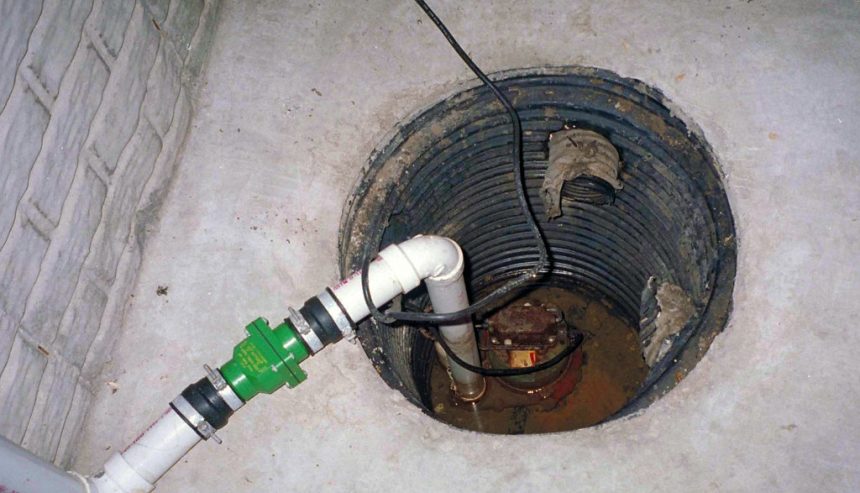Basements and crawl spaces often face the risk of flooding. One effective way to prevent this is by installing a sump pump. These devices work to keep your belongings safe from water damage caused by heavy rains, natural disasters, or plumbing issues.
Sump pumps also come in handy for removing sewage or excess water from areas in your home where there’s no drainage system available. They essentially act as guardians, ensuring that your home stays dry and protected from water-related problems.
What Is A Sump Pump?
A sump pump is a device typically installed in basements or crawl spaces to prevent flooding by removing excess water. It consists of a pump, usually placed in a pit or basin called a sump, which collects water and then pumps it away from the building to a safe location.
How Sump Pumps Work
When water accumulates in the sump pit, a float or sensor activates the pump, which then pumps the water out of the pit through a pipe and away from the building. This process helps to keep the area dry and prevent water damage to the property.
Benefits Of A Sump Pump
1. Flood Prevention:
Sump pumps help prevent flooding in basements and crawl spaces, protecting your belongings from water damage.
2. Peace of Mind:
Knowing that you have a sump pump installed can provide peace of mind, especially during heavy rains or in flood-prone areas.
3. Reduced Mold and Mildew:
By keeping the area dry, sump pumps help to reduce the risk of mold and mildew growth, which can cause health problems and damage to the building.
4. Increased Property Value:
Having a sump pump installed can increase the value of your property, as it demonstrates proactive measures taken to protect against water damage.
Functions Of A Sump Pump
1. Water Removal:
The primary function of a sump pump is to remove excess water from basements and crawl spaces, keeping them dry and free from flooding.
2. Drainage:
Sump pumps drain water away from the building to prevent it from pooling around the foundation, which can lead to structural damage over time.
3. Backup System:
Some sump pumps come with battery backups or secondary pumps to ensure continuous operation, even during power outages or when the primary pump fails.
4. Moisture Control:
By maintaining a dry environment, sump pumps help control moisture levels in basements and crawl spaces, reducing the risk of water-related problems such as rot and decay.
Who Should Consider Installing a Sump Pump?
Sump pumps are invaluable tools for maintaining a dry home, yet they’re not necessary for every household. Here’s who might benefit from installing one:
- Those in Wet Climates: If your area experiences frequent heavy rainfall or snowfall, a sump pump can help prevent water buildup in your basement or crawl space.
- Residents of Flood-Prone Areas: If your home is situated in a low-lying region prone to flooding, especially if standing water is common after rain, a sump pump could be crucial for protecting your property.
- Those with Past Flooding Issues: If your basement has flooded before, or if you regularly deal with high moisture levels, a sump pump can provide proactive defense against future water damage.
- Homeowners with Finished Basements: Even if you don’t live in a flood-prone area, a sump pump can safeguard finished areas of your basement from potential water damage, offering added peace of mind.
Backup Options for Sump Pump
Here are three popular backup options for your sump pump:
Battery Backup for Your Sump Pump:
Pros: Easy to install, inexpensive, and requires minimal maintenance. Doesn’t rely on water supply.
Cons: Limited power output, typically lasts around five years, and may require periodic cleaning.
Best For: Occasional power outages and temporary solutions.
Water-Powered Sump Pump Backup:
Pros: Operates continuously as long as there’s water supply, minimal maintenance, and can last up to 20 years.
Cons: Requires professional installation, may result in higher water bills, and not compatible with well systems.
Best For: Major flooding and extended outages.
Portable Backup Generator for Your Sump Pump:
Pros: Provides uninterrupted power supply, can power other devices, and requires minimal installation.
Cons: High upfront cost, ongoing fuel expenses, and doesn’t start automatically.
Best For: Versatile use during both short and extended power outages.
In conclusion, when considering backup options for your sump pump, it’s essential to weigh the pros and cons of each solution against your specific needs and circumstances. Whether you opt for a battery backup, water-powered backup, or portable generator, each offers unique advantages and considerations.
Also, learn how to stop your sump pump line from freezing during winter.
Ultimately, the best choice will depend on factors such as the frequency of power outages, the severity of potential flooding, and your budgetary constraints. By carefully evaluating these factors and selecting the backup option that aligns best with your requirements, you can ensure the continued protection of your home against water damage, even in the face of unforeseen challenges.




 PuroClean Emergency Fire, Water and Mold Damage Restoration New Jersey
PuroClean Emergency Fire, Water and Mold Damage Restoration New Jersey